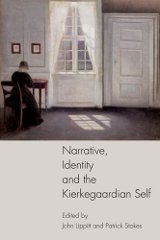 I’m delighted to say that Narrative, Identity and the Kierkegaardian Self is now available.
I’m delighted to say that Narrative, Identity and the Kierkegaardian Self is now available.
Edited by John Lippitt and myself, this is the first collection on Kierkegaard and narrative personal identity in over a decade – think of it as Kierkegaard After MacIntyre After Kierkegaard After MacIntyre – and brings together leading narrativists and Kierkegaardians in a new and productive dialogue. This book is one of the outcomes of the Selves in Time project and follows on from the conference we ran at Hertfordshire in November 2011. We hope it will mark an important moment in the ongoing discussion about what Kierkegaard can contribute to our understanding of the self.
But hey, don’t just take my word for it:
‘Are our lives enacted dramatic narratives? Did Kierkegaard understand human existence in these terms? Anyone grappling with these two questions will find in these excellent essays a remarkable catalogue of insights and arguments to be reckoned with in giving an answer. That is no small achievement.’
– Professor Alasdair MacIntyre, University of Notre Dame
Here’s what’s inside:
- The Moments of a Life: On Some Similarities between Life and Literature – Marya Schechtman
- Teleology, Narrative, and Death – Roman Altshuler
- Kierkegaard’s Platonic Teleology – Anthony Rudd
- Narrative Holism and the Moment – Patrick Stokes
- Kierkegaard’s Erotic Reduction and the Problem of Founding the Self – Michael Strawser
- Narrativity and Normativity – Walter Wieizke
- The End in the Beginning: Eschatology in Kierkegaard’s Literary Criticism – Eleanor Helms
- Forgiveness and the Rat Man: Kierkegaard, ‘Narrative Unity’ and ‘Wholeheartedness’ Revisited – John Lippitt
- The Virtues of Ambivalence: Wholeheartedness as Existential Telos and the Unwillable Completion of Narravives – John J. Davenport
- Non-Narrative Protestant Goods: Protestant Ethics and Kierkegaardian Selfhood – Matias Møl Dalsgaard
- Narrativity, Aspect, and Selfhood – Michael J. Sigrist
- The Senses of an Ending – Kathy Behrendt
- The End? Kierkegaard’s Death and its Implications for Telling his Story – George Pattison
